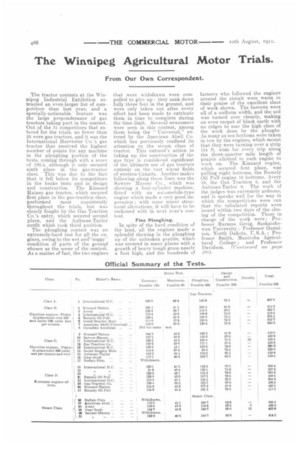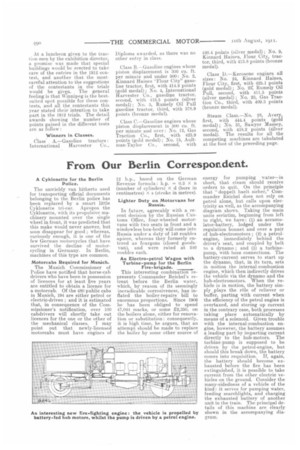The Winnipeg Agricultural Motor Trials.
Page 12

Page 14

If you've noticed an error in this article please click here to report it so we can fix it.
From Our Own Correspondent.
The tractor contests at the Winnipeg Industrial Exhibition attracted an even-larger list of competitors than last year, and a specially-noticeable feature was the large preponderance of gas tractors taking part in the contest. Out of the 31 competitors that entered for the trials, no fewer than 25 were gas tractors, and it was the International Harvester Co.'s gas tractor that received the highest number of points for any machine an the ploughing portion of the tests, coming through with a score of 180.5, although it only secured sixth place in the gas-tractor class. This was due to the fact that it fell below its competitors in the brake tests and in design and construction. The Kinnard Haines gas tractor, which secured first place in the gas-traction class, performed most consistently throughout the trials, but was closely fought by the Gas Traction Co.'s entry, which secured second place, and the Aultman-Taylor outfit which took third position.
The ploughing contest was an extremely-hard test for all the engines, owing to the wet and"soggy.' condition of parts of the ground chosen as the scene of the contest.. As a matter of fact, the two engines
that were withdrawn were compelled to give up : they sank down fully three feet in the ground, and were only taken out after every effort had been made to extricate them in time to complete during the time limit. Several newcomers were seen in this contest, among them being the " Universal," entered by the American Abell Co. which has previously confined its attention to the steam class of tractor. This entrant's action in taking up the construction of the i gas type s considered significant of the ultimate use of gas tractors entirely on the vast wheat fields of western Canada. Another maker following along these lines was the Sawyer Massey (7o., which was showing a four-cylinder machine, fitted with an an engine which made a very good impression ; with some minor structural alterations, it. will have to be reckoned with in next year's contest.
Fine Ploughing.
In spite of the hard condition of the land, all the engines made a splendid showing in the ploughing up of the unbroken prairie, which was covered in many places with a growth of heavy tough grass nearly a foot high, and the hundreds of farmers who followed the engines around the circuit were warm in their praise of the excellent class of work shown. The furrows were all of a uniform width, and the sod was turned over cleanly, making an even carpet of black earth with no ridges to mar the high class of the work done by tile ploughs. As many as ten bottoms were taken in tow by the engines, which meant that they were turning over a strip 154 ft. wide for every trip along the three-quarter mile length of prairie allotted to each engine to work on. The Kinnard engine, which secured first place, was pulling eight bottoms, the Rumely Oil Pull engine 10 bottoms, Avery 10, the Gas Traction 8, and the Aultrna.n-Taylor 8. The work of the judges was extremely arduous, and it speaks well for the way in which the competitions were run that the tabulated reports were issued within two days of the closing of the competition. Those in charge of the work were : Professor Burness Greig, Saskatchewan University ; Professor Gunnison, North Dakota, U.S.A. ; Professor Smith, Manitoba Agricultural College ; and Professor Davidson. (Continued on page
OW.
At a luncheon given to the traction men by the exhibition director, a promise was made that special buildings would be erected to take care of the entries in the 1912 contest, and another that the mostcareful attention to the suggestions of the contestants in the trials would be given. The general feeling is that Winnipeg is the bestsuited spot possible for these contests, and all the contestants this year stated their intention to take part in the 1912 trials. The detail awards showing the number of points gained in the different tests are as follow : Winners in Classes.
Class A.—Gasoline tractors : International Harvester Co., Diploma awarded, as there was no other entry in class.
Class B.—Gasoline engines whose piston displacement is 300 Cu. ft. per minute and under 500: No. 2, Kinnard Haines "Flour City" gasoline tractor, first, with 414.2 points (gold medal); No. 4, International Harvester Co., gasoline tractor, second, with 413.5 points (silver medal); No. 5, Rumely Oil Pull gasoline tractor, third, with 378.9 points (bronze medal).
Class C.—Gasoline engines whose piston. displacement is 500 cu. ft. per minute and over : No. 12, Gas Traction Co., first, with 423.9 points (gold medal) ; No. 15, Aultman-Taylor Co., second, with
420.4 points (silver medal) ; No. 9, Kinnard Haines, Flour City, tractor, third, with 413.8 points (bronze medal).
Class D.—Kerosene engines all sizes: No. 24, Kinnard Haines, Flour City, first, with 425.1 points (gold medal); No. 25; Rumely Oil Pull, second, with 411.5 points (silver medal); No. 23, Gas ;fraction Co., third, with 409.3 points (bronze medal).
Steam Class.—No. 28, Avery, first, with 141.4 points (gold medal); No. 31, Sawyer Massey, second, with 418.2 points (silver medal). The results for all the competing machines are tabulated at the foot of the preceding page.


















